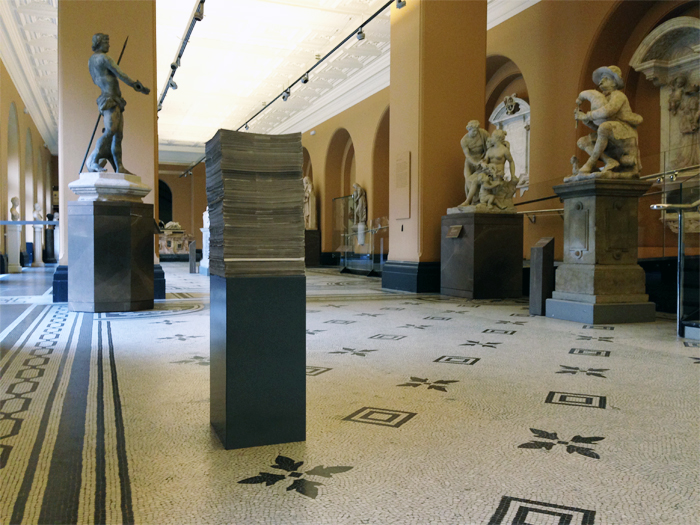
A Quiet Disposition, my weak AI for gathering information about drones, is now open to the public online, and anyone can review it. AQD scours the public internet for information about UAVs of all forms, and analyses it, extracting names, companies, locations, and anything else it can make sense of. Running since January 2013, the database contains 25,644 people, 33252 documents, and 76414 terms – all linked by semantic analysis, bearing the signature of the drone.
I’ve previously shown AQD as a set of books, and a related visualisation, combing through the database to find pairs of names, linked by incriminating terms. The development of AQD has been assisted by the Open Data Institute’s Data as Culture programme, and for the Victoria & Albert Museum’s Digital Design Weekend, AQD has taken the form of a free newspaper, called The Remembrancer. 3000 of them are stacked up in the sculpture galleries, to be distributed over the course of the weekend. The editorial written for the back page of this publication can be found below.

In a series of articles in the Washington Post in October 2012, reporter Greg Miller revealed the existence of the Obama administration’s strategic database for pursuing terrorists, a “next-generation targeting list” called the “disposition matrix.” This database contains the names of suspected terrorists, together with “an accounting of the resources being marshalled to track them down, including sealed indictments and clandestine operations.”
The purpose of the disposition matrix is to determine the targets for the US covert drone programme, an ongoing programme of assassinations in Pakistan, Yemen, Somalia and possibly elsewhere. Previous to the announcement of the disposition matrix, the administration had repeatedly denied the existence of the so-called “kill lists”, but the killing continued. Between June 2004 and the end of 2013, these attacks killed an estimated 3105 people in Pakistan alone, including 535 known civilians and 175 children. (Sources: The Bureau of Investigative Journalism, New America Foundation.)
Drones—unmanned aerial vehicles—are a secretive technology, by nature and by design. Intended to operate in distant and hostile environments, they remain largely invisible both to their intended targets, and to the democracies which consent to their use. They also freight this secrecy to other areas of operation. Named spokespeople do not discuss the drones, they are the domain of the “unnamed official”. Even the London Metropolitan Police, in response to a series of Freedom of Information requests, have asserted the exception of the drone, and refused to discuss its use in civilian contexts. This secrecy extends to the information gathered on its behalf, the reams of data, and the means by which it is analysed and processed. In 2010, the New York Times reported that this deluge of data gathered by drones was overwhelming military analysts, who were looking to ‘big data’ solutions from the television and news industries to understand what they were seeing. The disposition matrix, too, is likely to consist of such automated, algorithmic systems to analyse and interpret the data fed into it. How much of its analysis is performed by humans, and how much by machines, we are unlikely to be told.
Occasionally, we are given glimpses into the ways the disposition matrix makes decisions, how it decides who will be killed. In February 2014, the Intercept revealed that the Joint Special Operations Command, which controls drone strikes in Yemen, Somalia, Afghanistan and elsewhere, often based its attacks on automated analysis of cell phone data: a cell phone signal detected at a known meeting of suspicious individuals and later detected travelling down a desert road in a remote part of the country could be enough to incriminate the person carrying it. A former JSOC High Value Targeting Team member stated that: “People get hung up that there’s a targeted list of people. It’s really like we’re targeting a cell phone. We’re not going after people – we’re going after their phones, in the hopes that the person on the other end of that missile is the bad guy.” These attacks are called “signature strikes”, undertaken on the basis not of a name, but on the signature, the appearance, of information itself.
This information is known as “metadata”. It consists not of the data itself—what people talk about, what they are planning—but the associations between them, networks of relationships which purport to reveal something about their intentions. NSA General Counsel Stewart Baker has stated that “metadata absolutely tells you everything about somebody’s life. If you have enough metadata, you don’t really need content.” During a debate at John Hopkins University in April 2014, Michael Hayden, a former Director of both the NSA and the CIA, confirmed that position, and went further: “We kill people based on metadata.”
A Quiet Disposition is an automated intelligence-gathering system which lives on the civilian network—the internet. It scours the web for information about drones, collected from news stories, blog posts and company reports. Using an open-source semantic analysis programme called Calais, developed by Thomson Reuters, it analyses the content of these texts to harvest their metadata: the names of people and places, of companies and organisations. From this information it builds a map of associations, its own network of inference and intention. Through their association, however distant, with the drone programme, these people and companies are implicated in the wider uses and abuses of the technology. A Quiet Disposition is a weak artificial intelligence: collecting information, drawing connections, building a picture. Since its inception in January 2013, the database has expanded to include some 25,000 people, 32,000 documents, and almost 75,000 “terms”—locations, technologies, titles and industries.
The City Remembrancer is an officer of the City of London, the financial and semi-independent centre of the nation’s capital, whose role is to communicate the desires of the City to parliament. Writing in the Guardian, George Monbiot described the Remembrancer thusly: “The City of London is the only part of Britain over which parliament has no authority. In one respect at least the Corporation acts as the superior body: it imposes on the House of Commons a figure called the remembrancer: an official lobbyist who sits behind the Speaker’s chair and ensures that, whatever our elected representatives might think, the City’s rights and privileges are protected.”
The City of London is also home to the FTSE 350 index, a list the largest 350 companies by capitalisation which have their primary listing on the London Stock Exchange. Of these 350 companies, 46 are known to A Quiet Disposition, identified in its long trawl through the deep web. Some of these companies are directly associated with the drone programme, such as BAE Systems and Qinetiq which design and build automated systems, to less obvious suspects, such as British Telecom, which constructed the dedicated fibre-optic link from RAF Croughton in Northamptonshire to Camp Lemonnier in Djibouti used by the US Air Force to operate drone strikes. Other companies may seem even more distant, but in their dealings the system has, somehow, detected the signature of the drone. They are implicated by association.
The Remembrancer, this newspaper, is one form of the information held in the database—but it’s barely readable. Or at least, its readable, but its near incomprehensible. The stories it tells are generated from the information it has gathered, in the same way that spam emails are generated: text from real sources, garbled by the machine as it attempts to make sense of them, and tell them back to us. Terms which are significant to the system are highlighted, weighted with meaning, but the meaning assigned to them by an algorithm, a non-human near-intelligence. The information it has gathered is too vast to be comprehended in its totality by us, but we must try to make sense of it. Lives depend upon it.
“Big Data”, the slippery term for the overwhelming flood of information unleashed by our increasingly surveilled and analysed world, is both promise and menace. It plays into our universal desire to know more about the world, and thus to operate in it more efficiently, but downplays the extent to which the world is shaped by the data that we choose to gather, the technology that gathers it, and the politics of those who design that technology. Increasingly, we inhabit a world where decisions are made by unknowable machines; not a dystopian future, but a banal recreation of the present, constructed from the traces of phone calls, credit card transactions, voting records. In this world, we must take responsibility not only for our own actions, but the actions of the vast non-human assemblages we have built around us—from corporations to complex software systems—and acknowledge the moral and physical limits of our technologies, and ourselves.

Comments are closed. Feel free to email if you have something to say, or leave a trackback from your own site.